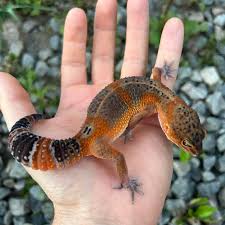GECKO MANDARIN BLACK NIGHT – LIGHT (Eublepharis macularius)
$200.00
Full Description
Here is a dedicated care guide for the Mandarin Black Night (Light) Leopard Gecko — a morph blending the rich pigmentation of the Black Night line with vibrant orange tones from the Mandarin lineage. The “Light” designation generally refers to animals that are not solid black but have lighter body coloration, such as dark gray, charcoal, or black with visible tangerine or orange highlights.
Mandarin Black Night (Light) Leopard Gecko Care Guide
Scientific Name: Eublepharis macularius
Morph Genetics:
-
Black Night – line-bred for extreme melanism
-
Mandarin – line-bred for deep orange coloration
-
Light variant – lighter-bodied individuals from this cross (gray to dark brown base with orange patterning)
Morph Type: Line-bred polygenic traits
Difficulty: Intermediate
Size & Lifespan
| Trait | Range |
|---|---|
| Adult Length | 7–10 inches (18–25 cm) |
| Adult Weight | 50–90 grams |
| Lifespan | 15–20 years (captive) |
Enclosure Requirements
Tank Size
-
Juvenile: 10–20 gallons
-
Adult: 20–40 gallon breeder (36″x18″ floor space preferred)
Substrate
| ✅ Safe | ❌ Unsafe |
|---|---|
| Paper towels | Loose sand |
| Reptile carpet | Calcium sand |
| Slate or ceramic tiles | Bark or wood chips |
| Bioactive (advanced setups) | Gravel |
Hides & Decor
Provide at least three hides:
-
Warm hide (over heat mat)
-
Cool hide (for thermoregulation)
-
Humid hide (aids shedding; moist sphagnum moss or eco-earth)
Additional decor:
-
Rocks, cork bark, fake plants, tunnels for enrichment
️ Heating & Humidity
| Zone | Temp (°F) | Temp (°C) |
|---|---|---|
| Warm side | 88–92°F | 31–33°C |
| Cool side | 75–80°F | 24–27°C |
| Nighttime | 68–72°F | 20–22°C |
| Humidity | 30–40% ambient, 70–80% in humid hide |
Heating
-
Under-tank heater (UTH) on a thermostat is essential for belly heat
-
Optional low-wattage basking bulb if ambient temps are too low
-
Monitor floor temps using a digital probe thermometer
Lighting
-
UVB optional but beneficial: 5% linear UVB (e.g., Arcadia ShadeDweller)
-
Avoid bright or intense white light — Black Night lineage may have light-sensitive eyes
-
Use a 12-hour day/night cycle
-
Provide shaded areas and hides to avoid overstimulation
Feeding & Nutrition
Insect Options
-
Staples: Crickets, dubia roaches, black soldier fly larvae, mealworms
-
Occasional Treats: Superworms, waxworms
Feeding Schedule
| Age | Frequency |
|---|---|
| Juvenile | Daily |
| Adult | Every 2–3 days |
Supplementation
| Supplement | Frequency |
|---|---|
| Calcium (no D3) | Always available |
| Calcium + D3 | 1–2× per week |
| Multivitamin | 1× per week |
Always gut-load feeder insects 24 hours before feeding.
Maintenance
-
Daily: Remove feces, refresh water
-
Weekly: Clean hides, spot clean substrate
-
Monthly: Full substrate refresh or enclosure wipe-down
-
For bioactive setups: maintain clean-up crew (isopods/springtails) and monitor moisture balance
⚠️ Morph-Specific Considerations
| Trait | Note |
|---|---|
| Light sensitivity | Mandarin Black Night geckos may have Eclipse lineage; keep lighting soft and indirect |
| Color retention | Bright colors fade in stress or overexposure to light — keep handling gentle and environment low-stress |
| Heat absorption | Even “Light” Black Night morphs may retain heat more easily — monitor warm zone temps precisely |
| Genetic health | Avoid inbreeding; outcrossing helps maintain vitality and proper coloration in line-bred morphs |
Handling Tips
-
Begin handling after 1–2 weeks of acclimation
-
Limit sessions to 5–10 minutes initially
-
Always handle close to the ground and support all limbs
-
Avoid handling during shed cycles
✅ Summary Checklist
| Item | Recommendation |
|---|---|
| Enclosure | 20–40 gal breeder tank |
| Heating | UTH + thermostat (88–92°F) |
| Lighting | Low-output UVB (optional), soft ambient light |
| Hides | Warm, cool, and humid |
| Diet | Insectivorous, gut-loaded |
| Supplements | Calcium + D3 and multivitamin |
| Substrate | Tile, paper towels, or safe bioactive |
| Stress reduction | Avoid bright lighting, overhandling, or overcrowding |

